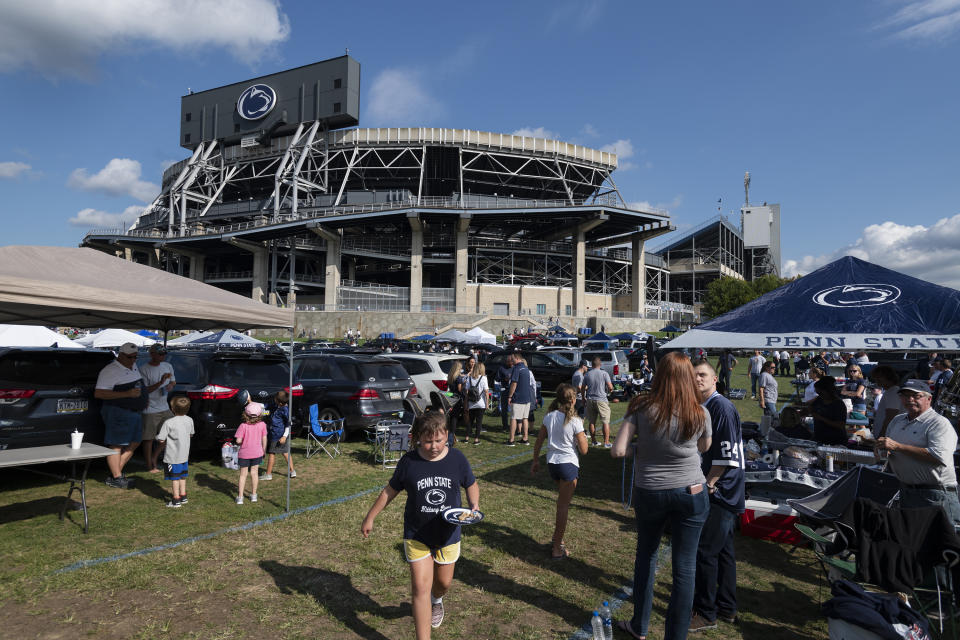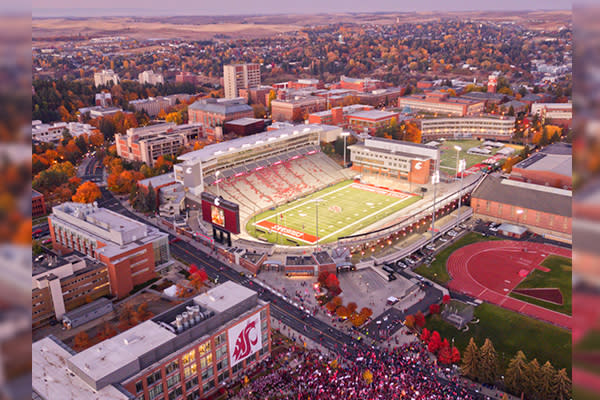Silent Saturdays: College towns weigh a fall without football
The excitement starts building a hundred hours before kickoff.
Seven Saturdays every fall, RVs from every point on the compass roll onto the Palouse in Eastern Washington bound for Pullman, home of Washington State University. Alumni roam campus, deciding which of their stories they can share with their children. Bars along Colorado Street call in extra staff. The Cougar Marching Band tunes up as Butch T. Cougar gets loose.
More than 2,000 miles to the east, State College, Pennsylvania, fills to bursting as alumni of Penn State return up U.S. 322 to Happy Valley, swarming the restaurants, college bookstores and streets on campus. Nobody sleeps very much on gameday weekends. Some fans post up on the route the team buses take to Beaver Stadium; others head to The Creamery for some pregame ice cream. Everyone’s angling to get a photo with the Nittany Lion as the Blue Band plays all day long. From dawn to long past sunset, chants of “WE ARE!” ring out across Happy Valley.
That’s how it ran until this year, and that’s how it might run in 2021. For now, though, towns like Pullman and State College, inextricably linked to their universities and their football teams, are looking at a desolate fall and an uncertain future.
“What the hell are we going to do every Saturday this fall?” wonders Marie Dymkoski, executive director of the Pullman Chamber and Visitor Center. “I feel a little bit lost.”

Economic devastation awaits empty college towns
One of the most familiar statistics in college football is the old one about how a full Saturday stadium at good old State U. is the population equivalent of one of the largest cities in the state. Penn State’s Beaver Stadium holds more than 100,000 people, making it Pennsylvania’s fourth-largest collection of humanity on gameday. Capacity at Wazzu’s Martin Stadium is three times the city’s population of 12,000.
But those numbers will drop to zero for the fall of 2020 after the Big Ten and the Pac-12 decided on Tuesday to cancel football for the rest of the year. The consequences will be dire across both conferences, but in small, football-mad communities like Pullman and State College, the effects will be devastating.
“We have built our business and our community for Washington State, specifically football and sports,” Dymkoski said. “Our business plans are very different than a stable community’s business plans. We are feast or famine.”
“This is easily going to be the most impactful in towns that are in this sweet spot, where the smaller the town is, the higher the [game] attendance is,” said Adie Tomer, a fellow at the Metropolitan Policy Program at the Brookings Institute. “When you’ve got a stadium that’s holding 80,000, a hundred thousand-plus, and only 20 to 25,000 are students, those are massive economic impacts.”
Alumni travel from all over the country to return to their alma maters on Saturdays in the fall, bringing not just kids to bore with old stories, but also dollars that stay in town.
“It’s the lifeblood of this community,” said Happy Valley Adventure Bureau president and CEO Fritz Smith of Penn State football. “It draws people back to the community in huge numbers. Football is probably the single biggest economic driver in the community.” Smith estimates that the economic impact of Penn State home games is $70 million to $80 million apiece, and that loss — on top of the dollars that vanished when students left town in mid-March — is catastrophic.
“This was another kick in the shins,” Smith said. “We’ve gone cold turkey on sports for some time now, and everybody was looking forward to fall football. Now that’s been yanked away from us, and there’s a lot of, ‘What are we going to do?’ ”
“The economic impact will be significant,” Tomer said. “Most critically, there’s no replacement for what’s being lost. Those games aren’t coming back. There will be an absolute concrete loss of sales to a full suite of game-serving businesses.” There’s the obvious loss to dining, retail and lodging businesses, but also other “off-the-books” businesses: Front yards turned into parking lots, churches and Scout troops selling lemonade and barbecue, all the small elements of a full game-day experience.

Cultural impacts will also hurt
If you’ve ever been in a college town on a bye weekend, you know the feeling of absence, of loss, the sense that something should be happening but isn’t. Now, imagine that feeling spread out over an entire season.
There’s so much more to college football than a score, and there’s more to a college football weekend than just the game. Parking lots and tailgating spaces will sit empty. The sound of the marching band won’t echo across campus. Beloved local hangouts like The Coug in Pullman and The Corner Room in State College might have a few regulars stop in for old times’ sake, but nothing like the wall-to-wall crowds on a typical game day. Something irreplaceable will be lost this fall.
“Colleges are manufacturers of services, which is to say education,” says Tomer. “But they also manage experiences. There’s nothing that holds a candle in terms of a single-day experience like a Saturday college football game, especially in these towns.”
That experience, that bonding between fan and university, will endure long after the fall of 2020 is just a bad memory. It will take more than one season without football to sever the connections between universities and their fans.
“Culture is such a difficult area to get a handle on, but it’s clearly of extreme value,” Tomer says. “I hesitate to think, from a football perspective, it will lead to a sustained loss of connection to universities. There are so many other things that tie us to our universities. When football returns, that will return to being our cultural currency, how we relate to our alma maters.”
Some aspects of the college football season will live on even without games. Wazzu is the home of one of college football’s finest traditions — the flag, dubbed Ol’ Crimson, that waves at every single airing of ESPN’s “College Gameday,” no matter where it’s based. That tradition will continue, says CJ McCoy, managing director of the Ol’ Crimson Booster Club.
“If there’s an opportunity for that flag to rise, we’re going to do it,” CJ said, adding, “It’s just disappointing we won’t get to welcome ‘College Gameday’ in Pullman again this fall and that the [Washington] Huskies will have to wait until next season to get pummeled on the Palouse.” (Rivalries, of course, are invulnerable to COVID-19. That’s science.)
The long wait for football’s return
The question for towns like State College and Pullman now is what to do until football returns.
How will football-starved fans occupy their time?
“I’m going to have to rake leaves in September,” Pullman’s Dymkoski says with a laugh, then turns serious. “It’s a real pall, a real negative, depressing pall on the community. I don’t know what it’s going to look like [this fall]. I worry about the mental health of everyone here: students, kids, adults. It’s a lot to take in. [Not having football] is just one more notch in the belt.”
Spring could bring some measure of salvation. The Big Ten has begun talks about how to put together a season in the spring, and that could provide some economic relief. But it might not come soon enough for small businesses already struggling after what would be almost a full year of depressed, even nonexistent revenue.
“They may not have the runway [to survive],” Tomer said. “Depending on their cash reserves, when they have to renew their leases, those losses of sales of three to six months, it may not be good enough to sustain themselves.”
Still, in the absence of anything else to hold onto, there’s faint but definite optimism.
“There’s an awful lot of looking forward to the spring,” Smith says. “If football’s held in the spring, along with all the other activity and rejuvenation going on, we’re going to have a really thriving and exciting place. Our economic comeback would be something to behold.”
_____
Jay Busbee is a writer for Yahoo Sports. Follow him on Twitter at @jaybusbee or contact him with tips and story ideas at jay.busbee@yahoo.com.
More from Yahoo Sports:

